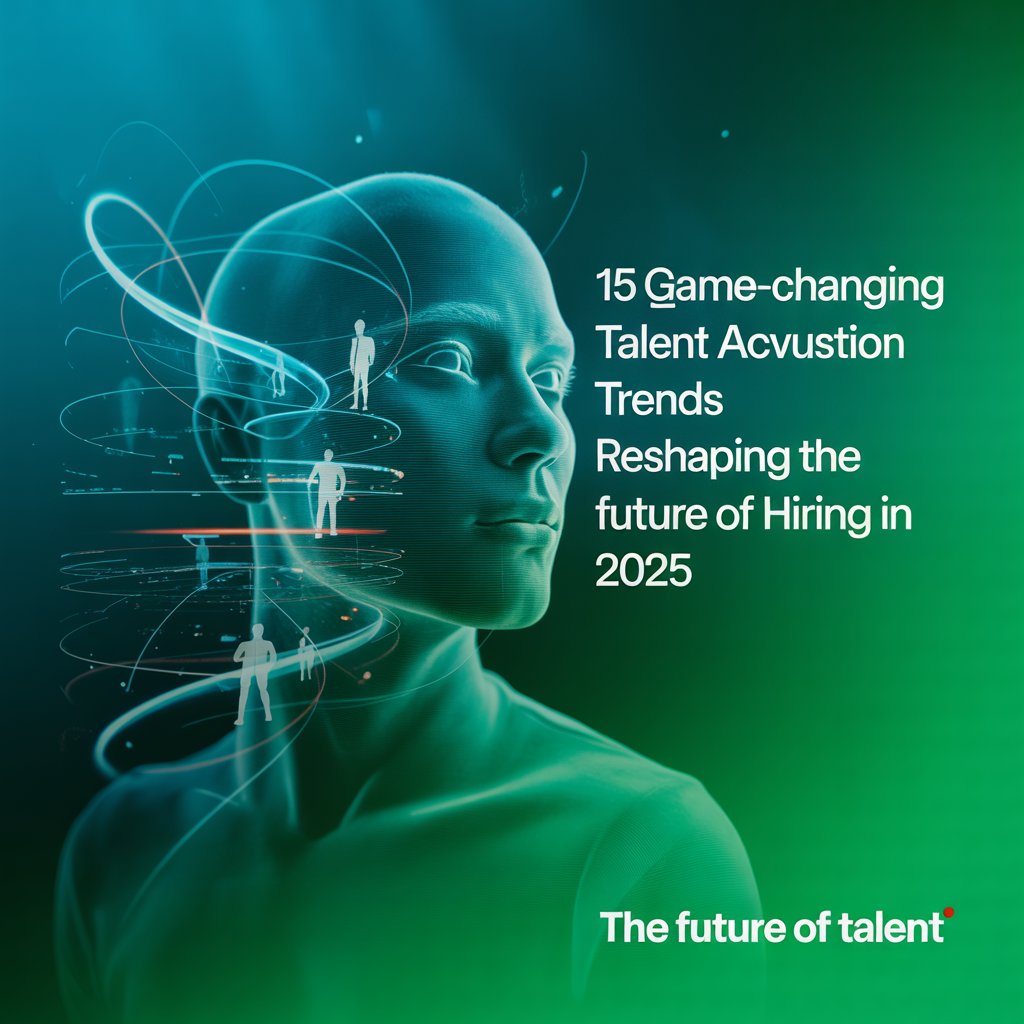
The New Era of Talent Acquisition
The landscape of talent acquisition in 2025 is undergoing a seismic shift. From the power of artificial intelligence to the rise of skills-based hiring, organizations are being pushed to rethink every step of their hiring process. Candidates are no longer just looking for a job—they’re seeking purpose, flexibility, growth, and alignment with company values.
This article dives deep into the 15 most impactful trends shaping talent acquisition today and beyond. Whether you’re an HR leader, recruiter, or business owner, understanding these trends is crucial to staying competitive and attracting top-tier talent.
1. AI and Automation in Recruitment
AI isn’t just a buzzword anymore—it’s the engine driving smarter, faster hiring.
How AI is Revolutionizing Candidate Screening
AI-powered tools now assess resumes in seconds, analyzing keywords, matching qualifications, and even predicting future performance. Tools like HireVue and Pymetrics use behavioral science and machine learning to create a full picture of a candidate beyond the CV.
Automation in Interview Scheduling and Communication
Chatbots, like Paradox’s Olivia, can schedule interviews, answer candidate FAQs, and streamline communication—reducing time-to-hire by up to 30%.
Pro Tip: Integrate your ATS with AI-powered plugins to reduce recruiter workload and enhance speed without sacrificing personalization.
2. Elevating the Candidate Experience
A poor candidate experience can damage your employer brand—and cost you talent.
Application Journey: Creating a Seamless Experience
Simplifying the application process, ensuring mobile optimization, and minimizing form fields can significantly boost conversion rates. Candidates expect smooth, intuitive experiences from job boards to final offers.
Personalization and Follow-Up Communication
Using automated yet personalized messages after every stage keeps candidates informed and engaged. Ghosting is a major turn-off—communication is key to keeping top candidates warm.
3. Making Data-Driven Decisions in Hiring
In 2025, gut feeling is out—data is in.
Predictive Analytics and Hiring Metrics
From sourcing to onboarding, every touchpoint can be tracked. Tools like Greenhouse Analytics help forecast hiring needs, optimize job ad placements, and identify bottlenecks in your hiring funnel.
Using Data to Improve Diversity and Retention
Analytics can identify DEI gaps and track retention rates based on hiring sources or interview panels. This empowers companies to take real action, not just check boxes.
4. Skills-Based Hiring: A Shift from Degrees to Competency
The global push for inclusivity and relevance in hiring has led to a sharp pivot toward skills-first recruiting. Big names like Google and IBM now hire based on demonstrated competencies rather than traditional qualifications.
Why it matters: This approach widens your talent pool and aligns better with real-world job performance.
5. Upskilling and Reskilling as a Competitive Advantage
Keeping employees’ skills sharp is not just smart—it’s essential.
Internal Training Programs
Investing in internal talent boosts retention and fills skill gaps faster than hiring externally. Platforms like Coursera for Business offer custom learning paths aligned with strategic goals.
Strategic L&D for Business Alignment
Learning and Development (L&D) must now serve business KPIs. Companies are building L&D dashboards that tie skill growth to ROI.
6. Strengthening Employer Branding
A powerful employer brand isn’t just a marketing asset—it’s a recruitment magnet.
Building a Brand That Attracts Passive Candidates
In 2025, candidates research companies just as companies screen candidates. Your LinkedIn presence, Glassdoor reviews, and career site storytelling all contribute to your employer image.
70% of job seekers will not apply to a company with a bad reputation—even if they are unemployed.
Source: Harvard Business Review
Telling Your Employer Story Effectively
Highlight your culture, employee stories, development programs, and social impact through content-rich platforms—blogs, videos, and podcasts. Authentic storytelling can dramatically improve application rates and offer acceptance.
7. Remote and Flexible Work: Redefining Hiring Geography
Remote work is no longer a perk—it’s an expectation. Flexible schedules and hybrid models have opened up global talent pools.
- Companies like GitLab and Zapier are now 100% remote.
- Flexible hours allow organizations to accommodate different time zones and boost productivity.
Tip: Promote your remote/flexible policies clearly in job descriptions and on your career page.
8. Diversity, Equity, and Inclusion (DEI) in Every Stage
DEI is now a core business function—not just an HR initiative.
- Implement blind resume reviews.
- Standardize interview questions.
- Create inclusive job descriptions using gender-neutral language.
Companies with high DEI scores outperform their competitors by 35% in profitability.
Source: McKinsey
9. Agile Recruiting for a Rapidly Changing Market
Agile recruiting adapts to evolving business needs through flexible, iterative hiring processes.
- Cross-functional teams.
- Short hiring sprints.
- Real-time feedback loops.
Use agile methodologies like Kanban boards or weekly sprints for team sync and candidate pipeline clarity.
10. Social Media Engagement for Passive Candidate Outreach
Social media is now the #1 channel for employer visibility and passive recruitment.
- Post job content on LinkedIn, Instagram, and even TikTok.
- Use employee advocacy and behind-the-scenes videos to build trust.
Engaged candidates are 40% more likely to accept job offers.
11. Measuring Quality of Hire: Beyond the Resume
“Quality of Hire” is now measured by:
- Job performance (KPIs)
- Cultural fit
- Time-to-productivity
- Retention rates
Use onboarding feedback and 90-day check-ins to assess long-term value.
12. Reducing Cost Per Hire Without Compromising Quality
You can lower costs while improving quality by:
- Using employee referral programs
- Automating repetitive processes
- Investing in strong employer branding (long-term ROI)
Average cost per hire in 2025: $4,700.
Efficient hiring can reduce this by 25–35%.
13. Rise of the Gig Economy and Freelance Talent
Platforms like Upwork, Toptal, and Fiverr have made access to high-quality freelancers easier than ever.
- Offers flexibility and faster hiring
- Allows specialized project-based work
- Reduces overhead costs
By 2027, freelancers will make up more than 50% of the U.S. workforce.
14. Promoting Employee Well-Being and Work-Life Balance
Organizations are prioritizing:
- Mental health support
- Four-day work weeks
- Paid sabbaticals and flexible PTO
This directly impacts retention, engagement, and productivity.
Companies promoting wellness see up to 21% higher profitability.
15. ESG and Talent Acquisition: A New Expectation from Candidates
Environmental, Social, and Governance (ESG) criteria are now integral to employer selection.
Candidates want companies that:
- Operate sustainably
- Support communities
- Champion ethical leadership
Include ESG efforts in your careers page and interviews to attract socially conscious talent.
❓ Frequently Asked Questions (FAQs)
1. How is AI changing recruitment in 2025?
AI streamlines processes like resume screening, scheduling, and candidate matching. It reduces bias and improves efficiency while offering data-backed decision-making.
2. Why is employer branding so important now?
Because candidates research companies thoroughly before applying. A strong employer brand builds trust, attracts passive candidates, and improves offer acceptance rates.
3. What is skills-based hiring?
It focuses on practical skills and competencies rather than degrees. It promotes diversity, inclusivity, and relevance to job performance.
4. How do I measure the quality of hire?
Use indicators like job performance, time-to-productivity, retention rates, and cultural fit feedback collected during onboarding and the first 90 days.
5. How can companies promote DEI effectively?
By standardizing interviews, using blind resume reviews, inclusive job ads, and tracking DEI metrics throughout the hiring funnel.
6. What’s the benefit of recruiting through social media?
It helps reach passive candidates, boosts employer branding, and engages audiences where they already spend time—especially Gen Z and millennials.
✅ Conclusion: Preparing for the Future of Work
Talent acquisition in 2025 is defined by agility, technology, and human-centric strategies. From leveraging AI and data to championing DEI and employer branding, successful hiring today means being proactive, inclusive, and strategic.
Companies that embrace these trends won’t just survive—they’ll lead.
🚀 Ready to Future-Proof Your Hiring Strategy?
At HIB Recruitment Services, we help companies stay ahead in the talent race. Whether you’re a startup or an enterprise, our modern, people-first hiring solutions are designed to help you:
- Attract top talent globally
- Build inclusive, data-driven recruitment pipelines
- Strengthen your employer brand
- Optimize cost per hire and time to fill
👉 Partner with us today and transform your recruitment process for 2025 and beyond.
🌐 Visit hibrecruitmentservices.com
📧 Let’s talk: contact@hibrecruitmentservices.com
📣 Follow us on LinkedIn & Instagram for hiring insights, trends & tips

Leave a Reply